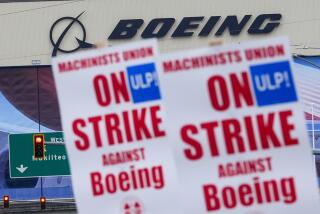Air Force preps to end C-17 line at Boeing’s Long Beach plant
AsBoeing Co.’s beleaguered cargo jet-making complex in Long Beach faces dwindling orders for its huge planes, the Air Force has issued a $500-million contract to begin planning the shutdown of the assembly line.
With no new orders, the factory could shut down completely by late 2014, but Boeing officials say the end may not be at hand.
C-17 program manager Bob Ciesla says foreign countries need cargo planes and the company may still develop a commercial version of the plane. So, he said, don’t count out the 1.1-million-square-foot plant — and the 6,000 people employed there — just yet.
“We are actively pursuing international sales and see strong customer interest in the capabilities only the C-17 can deliver,” Ciesla said. “Boeing’s Long Beach facility is the last production lines in the U.S. where a large military aircraft such as the C-17 is produced, and maintaining this capability provides a future option for America and its allies and global partners.”
The contract for $500 million announced last week calls for Boeing to transition to “post production, which will provide for orderly transfer of C-17 production assets,” which include spare parts and tools, to the Air Force.
Daryl Mayer, an Air Force spokesman, said the military is set to receive its 224th and final C-17 next year.
The C-17 Globemaster III is a massive, four-engine jet that can haul 60-ton tanks, troops and medical gear across continents and land on short runways. It has been in production at the Long Beach facility since the early 1990s.
For the last several years, Boeing has been pushing foreign sales as a way to help prolong the production line. But because most of these orders are relatively small — about five planes at a time — they have not been enough to sustain the production line for more than a few months.
The Boeing plant, next to Long Beach Airport, is one of the last major conventional aircraft factories in Southern California. It is also the largest private employer in Long Beach.
“I’m confident that Boeing will do everything in its power to extend the life of the line,” Long Beach Mayor Bob Foster said. “But we have to prepare for the end of operations there. That’s what happens to aircraft facilities: They eventually end.”
The Air Force stopped ordering C-17s in 2006. Since then, Congress has added last-minute appropriations for more planes to keep the plant rolling.
Congress has continually come to the program’s rescue, partly because it supports roughly 30,000 supplier jobs in 44 states.
In 2010, lawmakers set aside funding for 10 new planes. That same year, then-Defense Secretary Robert M. Gates told Congress he would recommend that the president veto legislation that contains money to pay for any additional C-17s.
There were no new orders from the U.S. last year. With tightening federal budgets, continued C-17 funding this year from Washington is considered very doubtful.
With slowing orders from the Pentagon, Boeing cut 900 jobs at the plant in 2011. The Chicago company also announced that it slowed production rates to 10 aircraft a year from 15 to draw out the assembly line’s life by several months.
The slower production rates would buy time for the company to sell more planes to foreign buyers, Boeing said. Currently the company is making its sales pitch at the Farnborough International Airshow in England, one of the world’s largest aviation showcases.
Britain, Australia, Canada and Qatar now have C-17s in their fleets. Workers at the Long Beach plant will fill an order by India for 10 planes by 2014.
Foreign customers say they like the four-engine aircraft because it can carry bulky battle gear and use substandard runways. It can take off and land quickly despite its massive size.
The plane has been key in hauling supplies to Iraq and Afghanistan and on humanitarian missions all over the globe.
At more than $200 million a piece, the C-17 faces stiff competition from smaller and less-expensive transports such asLockheed Martin Corp.’s C-130J and an upcoming A400M that is being developed by Airbus parent European Aeronautic Defense & Space Co. But the A400M program has been delayed and has gone billions of dollars over budget.
Tom Captain, principal and vice chairman of financial advisory firm Deloitte’s aerospace and defense practice, said there is worldwide demand for cargo jets.
“Future heavy-lift requirements are driven by a need for quick responses for natural disaster relief, civil police action and of course military expeditionary campaigns,” he said.
Boeing has also been looking at developing a commercial version of the cargo jet for years. Called the BC-17, the plane would carry tons of cargo for private companies. Ciesla, the C-17 program manager, wouldn’t discuss details but confirmed those plans are still on the table.
“It’s too early in the process to talk about that,” he said. “Let’s just say there are ongoing plans.”
More to Read
Inside the business of entertainment
The Wide Shot brings you news, analysis and insights on everything from streaming wars to production — and what it all means for the future.
You may occasionally receive promotional content from the Los Angeles Times.











